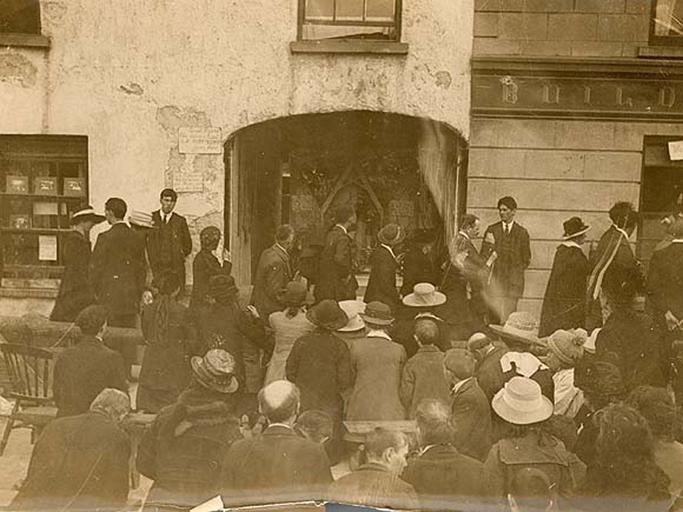MAKE A MEME
View Large Image

| View Original: | August_22,_1920.jpg (827x620) | |||
| Download: | Original | Medium | Small | Thumb |
| Courtesy of: | www.flickr.com | More Like This | ||
| Keywords: bleeding statues bleedingstatues crowds pilgrims james walsh jameswalsh dwan's dwans main street, templemore mainstreettemplemore templemore tipperary ireland irish war of independence irishwarofindependence august 1920 1920s w.d. hogan wdhogan hogan collection hogancollection national library of ireland nationallibraryofireland monochrome This photo shows a fraction of the thousands of people who flocked each day to visit and pray at "bleeding" statues set up in a yard beside T. Dwan's newsagents, Main Street, Templemore, Co. Tipperary in August 1920. The "manifestations" had appeared following Northamptonshire Regiment reprisals in the area for the killing of an R.I.C. officer by the I.R.A. A local woman, Miss Maher, told the Irish Independent correspondent that after: "the outburst in Templemore on Monday night [16 August 1920] some of the statues from which blood had been oozing in her house were taken by Walsh [first man to notice the "manifestations"] to Templemore, and it is believed that it was this action that saved the town from destruction." (Irish Independent, Monday 23 August 1920) And the furore did not die down quickly. Nearly a month later, this from the Irish Independent on Monday 13 September 1920: "The G.S.W.R. ran its first Sunday excursion train, since the war, to Templemore yesterday, at 9.50 a.m. (13/- 3rd class). Five minutes before its departure it was packed with 800 passengers, and 100 persons were left behind. Such was the success of the excursion that the company ran a second special immediately afterwards, consisting of 14 coaches. This train took up passengers from Kildare, Partarlington, and Maryborough. it carried 150 passengers from Dublin..." Date: 22 August 1920 NLI Ref.: HOG214 This photo shows a fraction of the thousands of people who flocked each day to visit and pray at "bleeding" statues set up in a yard beside T. Dwan's newsagents, Main Street, Templemore, Co. Tipperary in August 1920. The "manifestations" had appeared following Northamptonshire Regiment reprisals in the area for the killing of an R.I.C. officer by the I.R.A. A local woman, Miss Maher, told the Irish Independent correspondent that after: "the outburst in Templemore on Monday night [16 August 1920] some of the statues from which blood had been oozing in her house were taken by Walsh [first man to notice the "manifestations"] to Templemore, and it is believed that it was this action that saved the town from destruction." (Irish Independent, Monday 23 August 1920) And the furore did not die down quickly. Nearly a month later, this from the Irish Independent on Monday 13 September 1920: "The G.S.W.R. ran its first Sunday excursion train, since the war, to Templemore yesterday, at 9.50 a.m. (13/- 3rd class). Five minutes before its departure it was packed with 800 passengers, and 100 persons were left behind. Such was the success of the excursion that the company ran a second special immediately afterwards, consisting of 14 coaches. This train took up passengers from Kildare, Partarlington, and Maryborough. it carried 150 passengers from Dublin..." Date: 22 August 1920 NLI Ref.: HOG214 | ||||